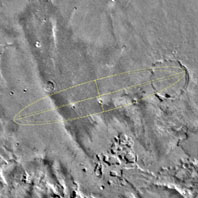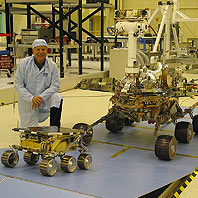Man on a MissionNo one can speak more knowledgeably or eloquently about NASA's Mars Exploration Rover (MER) mission than Steve Squyres. And that's only partly because Squyres, a professor of astronomy at Cornell University and former chairman of NASA's Space Science Advisory Committee, dreamed up the mission and serves as the principal investigator for its science payload. It has a lot to do with Squyres's unfettered passion for the pair of $400 million MERs that have probed martian rocks and soil since January 2004 to see if water, the prerequisite for life as we know it, ever existed on the planet. In this interview, conducted at the Jet Propulsion Laboratory in January 2003, Squyres talks about everything from why the MERs don't have life-detection instruments to why your laptop at home is "way smarter" than each rover's computer. Unleashing the roversNOVA: In a nutshell, what is this mission all about? Squyres: With this mission, we're asking: Where are the places on Mars where life might have been? Where was it habitable? We're going to do our very best to pick two places that have the maximum probability, we're going to land there, and we're going to do geology. We're going to understand as best we can what the environment was. If we find compelling evidence that sometime in the past this lake bed, this hot spring, or wherever we land was indeed the kind of environment that would have been suitable for life, then that's the place that you go to with your sample return mission, where you get some rocks and bring them back to Earth and hand them off to the world's best laboratories and see if you can find that evidence. You've got to do it stepwise. If you try to go for it all at once, you may come away with nothing. NOVA: The selection of MER was the end of a long roller-coaster ride for you. What is this thing that got selected? And what does it mean to you to finally see it happen? Squyres: Well, what got selected was a big, capable robot field geologist. It's a rover that weighs 350 pounds, and it can travel dozens of yards a day across the martian surface. It has a whole tool kit of scientific experiments that gives it the kind of capability you'd want a human field geologist to have on Mars. It provides us with the capability to do exploration that has never been done before on the surface of another planet. [For a closer look at the MER, see Anatomy of a Rover.] “The first time I stood next to the rover and watched it drive, it brought tears to my eyes.” What it means to me personally to be able to walk down to the Spacecraft Assembly Facility and see those rovers, I can't find the words for it. I've been dreaming about this for so long, and there have been so many points along the way where it looked like we wouldn't get the things built, let alone put them on top of rockets and send them off to Mars, that the first time I stood next to the rover and watched it drive, it brought tears to my eyes. You know, I try to be this steely-eyed space explorer dude, but it was just too much seeing that. It was a phenomenal feeling. NOVA: After all the hands-on control that you've had up to this point, it must be tough to let go. Squyres: When it's off on its own and it's flying, that's going to feel strange. We've been pouring our hearts and souls into these two pieces of hardware for years now, and we're going to put them on top of two big rockets. We'll light the fuse, and in a matter of seconds they'll be gone, and we'll never see them again. It's not that there will be a loss of control or contact, because we'll still be talking to them, and in ways that are very similar to the way that we do it now. But the oh-my-God-I'll-never-see-it-again part of it is a little weird. NOVA: It's incredible how all this effort hinges on the last five minutes of its flight to Mars. Squyres: Yes, during entry, descent, and landing, the rover is on its own. There is no back and forth between the vehicle and Earth. We've taught it what to do, and it does it or it doesn't. There's no intervention possible. There isn't enough time. From the time we hit the top of the atmosphere to when we're stationary on the surface is only a matter of minutes. Mars is too far away to interact with it at that kind of distance, so the thing has to be able to do it by itself. [See a visually stunning NASA animation of the MER flight at From Launch to Landing.] And there are a lot of things that can go wrong. If you just look at all the events that take place during entry, descent, and landing—there's deployment, there's parachutes, there's bouncing airbags, there's petals opening up. Any one of those doesn't work right, and we don't have a successful mission. NOVA: It's not just a matter of getting everything right at this end. There's some luck involved, right? Squyres: Oh, certainly. We don't have the capability to pinpoint the landing, to go to a specific location on the surface of Mars that we comprehensively know to be safe. We are picking big landing areas that are pretty safe over the entire area. But I can't tell you that somewhere in the middle of that there isn't a five-meter-tall, pointy, sharp rock that if you just happen to have a bad day you land on, pop your airbags, and that's it. We're all going to be holding on tight when the lander is due to touch down. Tough landingNOVA: Where do you want to go on Mars? Can you go anywhere you want? Squyres: First and foremost, I want to go someplace where we're going to land successfully. That's the most important thing. You can't go anywhere you want. There are a bunch of restrictions. Our vehicles are solar-powered, so you want the sun to be almost straight overhead. That means you've got to be near the equator. We can't land at high latitudes on Mars. You also can't land at high altitudes. The way we slow down is using a parachute, and the way a parachute works is that there's drag on the parachute as it goes through the atmosphere. If there's not enough atmosphere between space and the ground—in other words, if the ground's too high—you hit the ground going too fast and you're done. So there are restrictions on the altitude, the latitude, and so forth. When you add that up, we get kind of a funny-shaped band around the equator in which there are available landing sites. Once you get all the engineering constraints and safety stuff out of the way, then it boils down to science. The science of this mission involves going to places where there was liquid water in the past, so I want to go to places where there is absolutely compelling evidence that liquid water was present. The problem with that is that evidence for liquid water on Mars is never going to be 100 percent convincing, and it comes in different types. NOVA: Such as? Squyres: I'll give you two examples. One form of evidence that we find is what I'll call chemical evidence. The best evidence that we have for that is a mineral called hematite. On Earth, hematite mostly forms in places where there's liquid water, in big standing bodies like lakes or oceans, or in hot springs. Or it forms where cold water percolates through the ground and dissolves stuff. There are a few places on Mars, including one called Meridiani Planum that we can probably land on, where hematite is present. So that's a place where the chemistry of the surface, as viewed from orbit, tells you that maybe water was there. The problem with that is that there are other ways to make hematite too, and some of them don't involve water. So it's kind of an ambiguous signal that says water was here. The other kind of evidence for water comes from landforms. I'll give you a good example. There's a place called Gusev Crater, an impact crater maybe 100 miles across. It's got this huge, dried-up river valley flowing into it. It had to have been carved by water: water flows through the river valley, flows downhill, gets into this big hole in the ground. It's hard to believe that this thing didn't have a great big lake in it at some point in martian history. Sediments were surely deposited in that lake, so you should have a good sedimentary record of liquid water and whatever was going on there. Gusev Crater is a fabulous place to go. The problem with Gusev is that whatever happened there happened a long time ago. We're talking billions of years. Since then, other stuff could have happened. Impact craters could have chewed things up, lava may have flowed down onto the sediments. And we can't dig big holes with this rover. “Seeing a rock and going around it is real easy if you’re a human being or a gerbil or a cockroach.” So there's no slam-dunk winner here. There's no place where you can go and say, Oh yeah, that will be a place where there will be absolutely conclusive evidence for liquid water. There are a number of very, very tantalizing ones, and I hope we pick wisely. [Editor's note: NASA has since decided that "Spirit," the MER launched on June 10, 2003, will land in Gusev Crater, and "Opportunity," launched July 7, will go to Meridiani Planum.] In their elementNOVA: When these rovers wake up on Mars, what kind of a world will they be in? Squyres: It's hard to say exactly, because we've only been to three places on the martian surface, and the places we're going with MER are probably very different from those. I expect us to get some real surprises, especially with some of the landing sites we've been talking about. We do know that the rovers are going to be in a very hostile environment for a piece of hardware. They'll be in a place where there's dust to get in the joints, and the temperature varies by 100°C between nighttime and daytime, so solder joints and things like that get expanded and contracted. In a sense, though, they'll be in their native environment. This is the world they were designed for, so I think they're going to do okay. NOVA: Tell me about the ability of the rover to navigate on its own. First of all, what's so difficult about seeing a rock and going around it? Squyres: Well, seeing a rock and going around it is real easy if you're a human being or a gerbil or a cockroach. But it involves using optical sensors—eyes—to recognize an obstacle, be able to assess how much danger the obstacle poses, and then on the basis of that information make a decision. Do I keep going? Do I go around? And then also the intelligent capability to carry out that decision and deal with the consequences. What happens if I drive over? What happens if I go around? So you have to build into this vehicle a vision capability and a very modest level of artificial intelligence so it can deal with that. The way the rover does its business when it's driving is we have a pair of cameras down low on the front of the vehicle. They're called Hazcams, Hazard Avoidance Cameras. They look like eyeballs; they're sort of spooky-looking. Every foot or so, the rover stops, and the Hazcams take a picture, actually two of them in stereo. Those pictures are fed to the rover's computer. The rover takes those pictures and does what's called "automatic stereo correlation." Basically, it looks at them, tries to build up a 3-D understanding of what's in front of it, which it can do, because it's stereo. Then it kind of scratches its head and says, Is that bump, is that rock, is that feature in front of me so big that I can't drive over it? The basic rule is don't try to drive over anything bigger than a wheel. If it's bigger than a wheel diameter, you've got to go around. That's essentially the rule that we try to have the rover follow. If it decides that it's okay to drive forward, it will go forward another foot and then do the same thing again. If, on the other hand, it sees some rocks, some scary obstacle, something it doesn't like, then it will turn and drive around it. It has on board things like gyroscopes, to keep track of how much it turned. It has wheel odometry that counts the wheel turns to calculate how far it went, so it knows how far it went off the path it's supposed to be on. Once it knows the obstacle is back there someplace, it can turn and go back onto the path. NOVA: Why does it need this capability? Can't you just use a joystick? Squyres: I'd love to joystick it. I'd like to have real-time feedback, so it would be like actually driving a vehicle on Mars. The problem is that there's this enormous distance between Earth and Mars, so that it takes tens of minutes to send a radio signal to Mars and to have it come back with an answer, even at the speed of light. So we've had to build into the rover the capability, the autonomy, to do some things on its own. Little big computerNOVA: It must be challenging to have all these different things that have to happen all being run from one little computer. Squyres: Yeah, and that's actually something that's very different about MER compared to other ways that we've thought about going to the surface of Mars before. For example, on Mars Pathfinder, you had a little computer on board the rover, but the lander had a substantial computer, and that was the thing that was responsible for flying the spacecraft all the way to Mars. “You’d like to think of space hardware as cutting edge, the very best. No, no, you can’t do that.” On MER, the only computer on board the whole vehicle is the one inside the rover. Not only does the rover computer need to be able to drive around on Mars, deploy the instruments, and do the science observations, it also needs to know how to fly the spacecraft. It needs to know how to fire thrusters out in space to make a change in the spacecraft trajectory, that sort of thing. That's a lot of demands to put on one poor little computer. NOVA: How does its computer compare to the kind of computers people typically have on their desks? Squyres: It is primitive in the extreme. You'd like to think of space hardware as cutting edge, the very best. No, no, you can't do that. If you've got a laptop computer or PDA, if it breaks, you fix it. This thing breaks, that's $800 million down the drain. So you have to use extremely reliable hardware. You have to use hardware that has been demonstrated by test to be able to withstand the rigors of space—very low temperatures, in some cases very high temperatures, what can be a fairly extreme radiation environment—with extraordinarily high reliability. We're using a lot of 15-year-old technology, even almost 20-year-old technology on some parts of this vehicle, because that's the stuff that we can demonstrate is reliable out in space. So, yeah, your laptop computer is way smarter than my rover. NOVA: Why doesn't the MER have a life-detection instrument on it? Squyres: Because I don't know how to build one that'll work on Mars. If there is or was life on Mars, it's not easy to find. If it was easy to find, Viking would have found it. It may be deep below the surface; it may be only present in fossil form. It's very hard to come up with a life-detection experiment that you can point to and say, yes, that will give a definitive answer and have a high probability of finding what you're looking for. Maybe the only way to find life on Mars will be to drill down 200, 300, 400 meters. We don't have the technology to do that yet. So that's not what we're trying to do. We're trying to approach this problem one step at a time. We didn't include the capability to look for past life. We're not looking for fossils. Sure, if there's a dinosaur bone sticking out of the dirt, we'll see it. But that's not what this mission is about. High stakesNOVA: 1999 was a bad year for NASA's Mars Exploration Program. They lost both the Mars Polar Lander and the Mars Climate Orbiter. What's at stake with this mission? Squyres: I think the credibility of the Jet Propulsion Laboratory is at stake. I think the credibility of NASA's Mars program is at stake. A hell of a lot of science is at stake. The last 10 or 15 years of my career is at stake, from a purely personal perspective. There's an enormous amount at stake here, and everybody realizes it. NOVA: At what point does this become a successful mission for you? When do you breathe your sigh of relief? Squyres: That's a good question. You can answer it on different levels. The point at which I will feel it has been a truly successful mission is the point at which I feel that we have taken full advantage of the capabilities that these vehicles offer to answer the questions that we've gone to answer—the point at which there isn't that much more that we can learn with these machines. That's the point at which I really think we can say, yeah, it's been a successful mission.
But I will feel like celebrating the first day we've got six wheels in the
dirt. It has been such a struggle from the start of this idea back in 1995, to
the point where we're now just about ready to ship them to the launchpad. To
have taken it from the original concept to the point where we've got a rover or
two rovers on Mars in their native environment driving around and doing
science, I'm going to feel a certain measure of success just for getting that
far. |

Steve Squyres says the first time he saw the rovers drive, it brought tears to his eyes. "I try to be this steely-eyed space explorer dude, but it was just too much seeing that," he says. 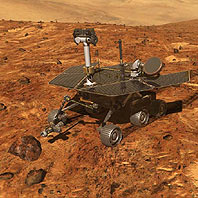
Guided by MER specialists back on Earth, each rover has traveled up to dozens of yards a day while investigating sites of interest. 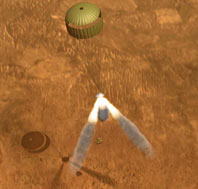
In the final moments before touchdown, the spacecraft deployed its parachute and fired retrorockets, slowing the airbag-encased lander down to a safe landing speed. 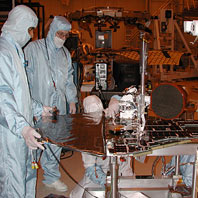
Jet Propulsion Laboratory engineers install a MER's solar panels in the Spacecraft Assembly Facility. 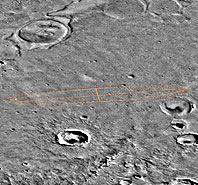
Gusev Crater (top) and Meridiani Planum are the two MER landing sites. The ovals located roughly in the center of each image are the so-called landing ellipses, which approximate the area in which each lander touched down. 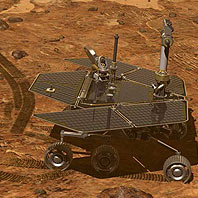
Mars is harsh, but the rovers were expressly built for such an environment and therefore should "do okay," Squyres said in this interview. He was right. 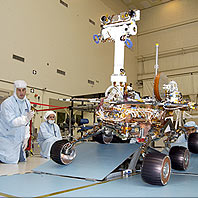
At the Jet Propulsion Laboratory, engineers drive one of the rovers over staggered ramps to test the range of motion in the robot's suspension. |
|
Interview conducted by Mark Davis, producer of "MARS Dead or Alive," and edited by Peter Tyson, editor in chief of NOVA online Mars Home | Send Feedback | Image Credits | Support NOVA |
© | Created November 2008 |


